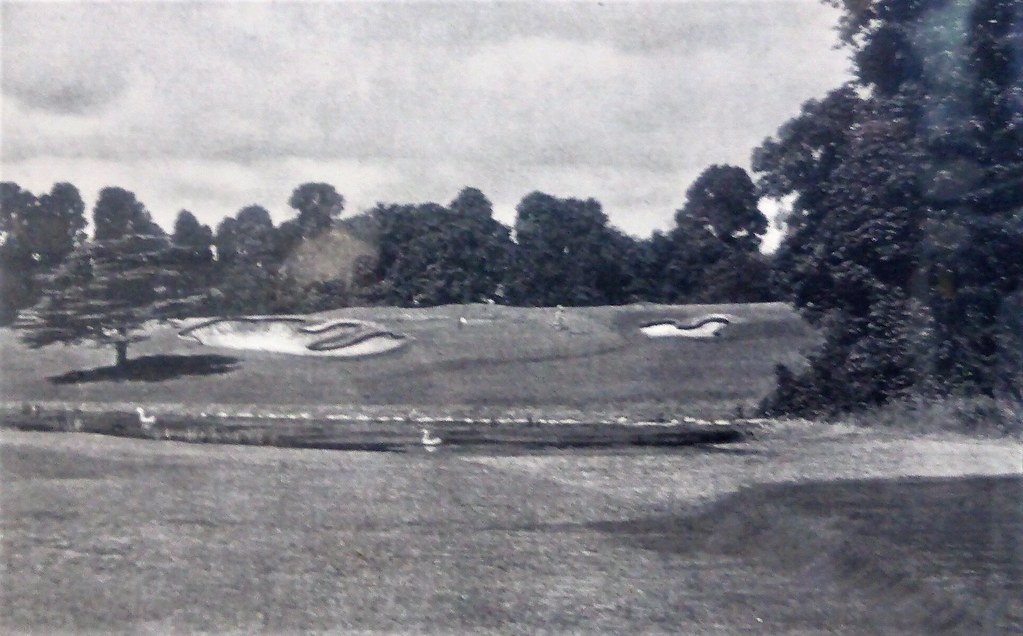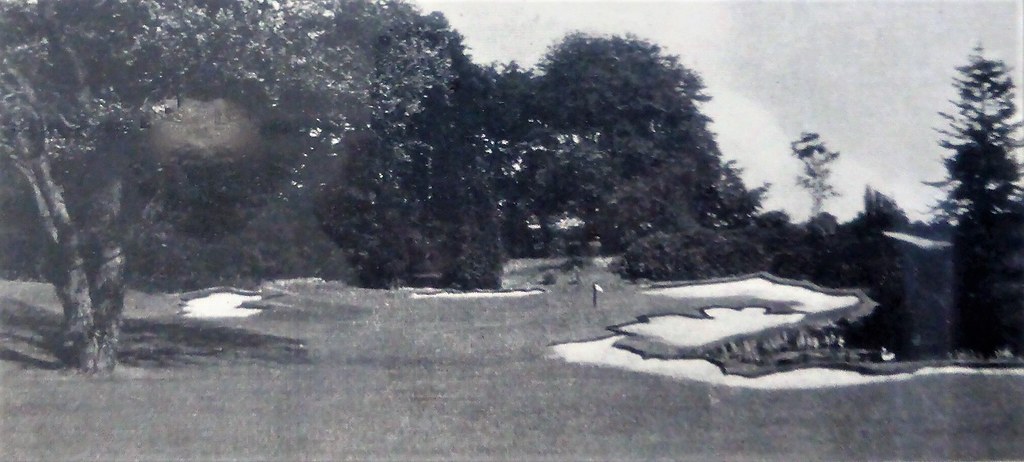The beautiful house prior to losing the top floor due to a fire.

It should come as no surprise that few know of Worcester G&CC, known locally as Boughton Park, because the course was built on the 19th century estate with landscaped gardens. The first association people make with Worcester is of course for its sauce. Chemists John Lea and William Perrins branded the sauce in 1837 and it is still produced in Worcester. There are many imitations, but there is only one original and genuine Lea & Perrins Worcestershire Sauce; no kitchen in the country is complete without a bottle on hand. Beyond the delicious sauce, the cathedral city of Worcester is rich with history. The last battle of the English Civil War took place in Worcester when Cromwell's forces defeated King Charlie's Cavaliers during the fall of 1651. In more recent times Sir Edward Elgar was a native of Worcester and it was the home to the world famous Royal Worcester Porcelain, perhaps the oldest English pottery brand in existence.
Befitting a handsome city such as Worcester, the course is one of pedigree. On the edge of the St John's quarter of the city, Dr Mackenzie completed what may have been his last original GB&I design in 1928, some 30 years after the founding of the club which was then called Worcester City GC. This club played over a 9 hole course which was called Tolladine: it closed in 2006. Having designed several distinguished UK courses such Alwoodley, Moortown, Cavendish and Hadley Wood, over the previous twenty years, Mackenzie was now a master of the craft.
With the River Severn flowing through the middle of Worcester, flooding has long been an issue and so it is the same for the course. A large part of the course covering fully five holes is often closed in the winter months and a makeshift course is assembled on the high ground. To be fair to Dr Mac, three of the holes in the flood plain, #s 9-11 are not of his design. Perhaps 15 years ago the former club pro designed these holes as a measure to eliminate dangerous situations with nearby traffic. The changes included
-The old 3rd through 5th holes were rubbed out by creating the par 5 third using the green of the old 5th; net loss of two holes.
-The old 14th fairway (now the 15th) was moved significantly right, away from the course boundary. This necessitated losing the old 16 & 17; net loss of two holes.
-New 9, 10, 11 & 17 were built.
-The routing on the 12th (old 11th) was changed to play down in the flood plain near the stream. In the winter, the hole is played on the ridge as originally planned by Dr Mac.
The alterations were highly controversial and for good reason. The new holes are not in keeping with the remainder of Dr Mac's design nor as a group could one call them good holes. By all accounts, two very good holes were lost in exchange for three holes which are out of play much of the year.
What remains of Dr Mac's vision is quite unusual. A great many greens are tightly bunkered left and right with the green surfaces squeezed as if in a corsett. It may sound outlandish, but I think the general concept of the green complexes is similar to Cypress Point. By that I mean many of the greens are lower than the surrounding bunkers with their fronts generally open. The result, if one is hoping to maximize their success, is a set of greens which must be approached from the dictated angle. Today, there are far too many trees to fully appreciate what would have been quite a wide open course that in fact required precision driving. Many of the holes have a clausterphobic feeling which greatly detracts from, what in my experience, is quite a unique Dr Mac design.
The first hole is very tight with the club entrance cutting into the drive zone from the right and trees down the left. A very well placed bunker can work as an aiming point if one is sensible and lays-up. A closer look of a theme running through the entire round; narrow greens that require the correct approach angle if one is to be successful.

The second too is a very tight drive with bunkers down the left and an oak to the right. The approach to the right to left/back to front canted green is very appealing. This green may have been moved a smidge to the right, but it looks very similar to old photos.

The relatively new three-shot third is a little kooky. The dogleg is very severe, looking like an upside-down L. Beyond a lovely oak are more trees down the right in two. One has to be content to play his second straight to the corner to set up a short third. All in all, quite an interesting green, compromised by trees over-doing a job the oak and right-hand bunkers perform very well. Silly trees on the corner of the dogleg. The course is plagued with bunkers blocking sightlines of bunkers.

A more open view. The fairway cuts across the 4th and the forward bunker is in the 4th fairway corridor. Perhaps chasing yardage and more par was the reason for the crossing holes. Whatever the reason...its not very clever.

The 4th is another par 5. While uncomfortably littered with trees some down the left have been removed. However, this remains a good hole because of the outstanding green. Like the first, the green runs away from play and is very difficult to hold if attacking from off angles.


Behind the green.

Turning back on the fourth, #5 is a decent par four hindered by limp bunkering. The sixth is a medium length par 3 with loads of trouble guarding the front half of the long, narrow green. Its probably best to play to the rear of the green no matter where the hole is cut. The general lie of the land leans well right. As on other holes, for some reason the club does not cut the entire green pad. This practice heightens the effect of the already narrow greens. The horrible evergreen back left is no longer there.

I like the green site for the 7th, but I don't believe the fairway is wide enough to accommodate the severe cant of the terrain left as the hole turns right. A large oak guards the inside of the fairway, invariably leaving a semi-blind approach from the rough. The delicate pitch will turn hard left after landing.

Not withstanding the issue of a hedge crowding the tee on the right and the tree/fountain combo, the 8th is another exceptional par 3. In trying to avoid the slippery downhill putt, the false front catches many a golfer out.

In the old days. The green has definitely been altered.

In this photo to the left rear of the green, the funneling effect to the front of the green becomes obvious.

The front nine finishes with the strongest of the four new holes. It is much safer to play well to the right of the green and let the hidden slope work to your favour. The 10th is an awful hole - a blind drive with the fairway feeding to a pond. I don't care for the short 11th either, but some of that is probably lingering loathing of the 10th. Luckily, what is likely the best par 4 on the course comes next. A large tree guards approaches from the left, the same side as the stream. Ironically, Dr Mac designed the hole to play from the ridge to the right on high ground. The 12th is a better hole using that corridor and it is used for the winter course. A photo of the proper approach used in winter. Notice how attractive the green site is...stepped beautifuly into the hillside. This is the only green without trees hampering the views and its only played in winter!

The approach from the summer course. Trees compromise what is a decent alternative fairway.

Taken from the rear of the green one can see the upper and lower corridors.

It is unusual for me to like drop shot par 3s, but the 13th is an exception because of the deception of space. The hole is actually quite tight to a water hazard on the left, but most golfers need a few rounds under their belt to fully appreciate this.

Many will have guessed that the next is a blind up n' over hole. The green is drivable, but gaining the angle of approach down the left should be the primary goal. Here we can see the difficulty of playing the second from the right side of the fairway.

#15 doglegs at a rather awkward distance requiring either a lay-up or a well shaped longer ball. Once again, bunkers pinch the green making the placement of the drive crucial. In the photo below it is easy to imagine the difficulty in approaching from too far off the centreline of the fairway.


A very good hole, the 16th is spoiled by trees down the left. One can imagine how a player is lured to the safe side away from the oak on the right only to leave the golfer high and dry with a terrible angle of approach. The penultimate hole, while not as good a par 3 as the previous few, is still good. The club seems to have been working a bunker project for years...sand colour and styles still don't match. project. The 17th used to have three bunkers in the front. There are now two and the soap dish like shaping has been changed, however, with the sand faces now removed the bunkers are far less prominent.
A difficult finisher, the 18th requires a long drive to have a go at the green in two. Similar to the 3rd, trees block the corner. It is also a pity trees hug the water because I think the pond would be more in play if folks weren't concerned about hitting wood and dropping into the hazard. Still, this is a fine hole.

In the old days.

I am critical of Boughton Park, but I do have a certain fondness for the course. I enjoy the many greens which are deep and narrow. The par 3s are good and there is a handful of attractive two-shotters. However, my reluctance to show many tee shots is because of how one-dimensional they are. The excellent greens are not properly showcased because one doesn't get many chances to approach from out of position. I live 10 minutes away and wouldn't consider joining; there are simply too many trees requiring kick outs when in trouble. Even so, if one is a fan of Dr Mac and finds himself near Worcester with spare time, Boughton Park is worth a look. 2024
Ciao